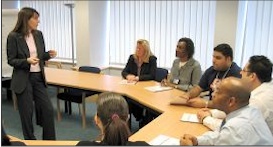 Whether you are starting a new year, a new quarter, a new job or a new role, a new project or just a new day, getting started is something that a surprising number of people struggle with. And yet it is a common situation we all face constantly.
Whether you are starting a new year, a new quarter, a new job or a new role, a new project or just a new day, getting started is something that a surprising number of people struggle with. And yet it is a common situation we all face constantly.
If you establish an effective system for just getting started properly you’ll be amazed at how much easier it becomes to ‘get it done’ and achieve rapid results.
Your system for getting started properly will, of course, vary somewhat in scope and detail for larger more complex projects or longer timeframes, compared to getting started on that unwanted job that has been sitting on your desk for weeks now.
If you are getting started on the whole future strategy for your organisation you will probably use a formal facilitated strategic planning process to most effectively get started and build team commitment to the process. If you are in a senior position and still struggle with getting started a good coach will guide you in implementing a system for getting started such as the simple Three-Step System I will share with you now.
Most of the time for most people, this system will be all the impetus that you need to get started on small and medium projects – and then get them done.
Step 1 – Context
Just as in any full scale and formal strategic planning process, your first step should always be to clarify your Context. In strategic planning we do this through a thorough exploration of the organisation’s vision, purpose, mission and values.
For smaller projects all you need to do is clarify your answers to the following questions:
- What do you want to accomplish? (Your mission)
- Why do want to do this? (Your purpose)
- What three or four goals achieved would equate to success with this project? (Your vision)
And that’s it! While complex corporates and large projects deserve a full and formal strategic planning process, your personal projects or daily tasks just require you to be clear about these three aspects of the Context in which you are working.
If you can’t answer these three question quickly and easily for all your projects, you are either wasting time doing useless tasks or you desperately need a coach to help you focus and operate more effectively.
Step 2 – Commitment
Once you have identified the context in which you are operating, your next step is to commit to the series of tasks required to achieve each of your 3 or 4 your goals that describe what success looks like.
For each goal draw up a list showing the following items:
- All the specific tasks required to achieve the goal
- The person responsible for each task, whether it is you or someone else
- The time or date a task is due to be completed
- The amount of time that will be required to complete it (or any deadlines or time constraints)
- The resources that will be required to complete it (or resource constraints)
Now is the time to drill down to the detail of exactly what you must do to complete the project. Not the things that you would like to do if you had time, or the things that have always been done before. Just the essential tasks required to achieve each goal. That’s it! Nothing more.
If there’s time you can always come back later and add frills and extras, but for now all you need to commit to is the minimum essential tasks to achieve your goals.
One of the common reasons why people don’t get started is because every time they think of starting, they think of all the additional things they could do to improve the project or outcome and each goal grows bigger and bigger and requires more and more effort and it all just gets too hard. Don’t let this happen to you.
For now commit to just the essentials – and nothing more.
Step 3 – Clear the Decks
Some people use tidying up their desk or office as an excuse to avoid actually getting started doing anything! But if you clear the decks as Step 3 of your Getting Started System, you will find it clears all the mental and physical space you need to start quickly and finish easily.
Get rid of distractions. Do what you have to do to prevent any interruptions for the next hour or whatever time you have allocated. Divert the phone, turn off your email, contact anyone who may need to speak to you before you start. Shut your door. Make it known that you are not available until your chosen time, absolute emergencies excepted and there had better not be any emergencies!
Just as you gather the physical resources you need to undertake any project, set things up so you have the time available to get started and work solidly for your allocated time.
And that’s pretty much it. Now that you’ve cleared the decks it’s time to get started – and get it done!
Follow this simple Three-Step System for Getting Started and you will be amazed and delighted at how your productivity and effectiveness explodes.
Download your Free Getting Started System and Worksheet
For details of Kerrie Mullins-Gunst’s Business Coaching Services and Group Facilitation Services visit our website at http://kmgconsulting.com.au
Have you got a system for Getting Started? Share your system and your feedback on my system by leaving a comment below.







Thanks for sharing this informative and practical tool for productivity and effective implementation of projects. It’s well thought out and really empowering.
I have been thinking on strategies to enhance my implementation/completion drives. I’ve come up with this guide.
Think through
Follow through
Review
Begin again
Effective programs should be able to answer the question of “what if” scenarios. This requires looking at your objectives from leadership and management stance.
Great process Ben. That’s a good way to follow through and continuously improve.
Hi Kerrie,
I like the ‘getting started’ article as it applies equally well to hobbies as to ‘real’ work.
One ‘black-hat’ comment if I may: For fun, I tried converting your article into Dutch and you need to be aware that the result was sadly hilarious, if that’s not an oxymoron. I still speak Dutch pretty well, but this was practically unreadably bad. Have you had any others check out some of the translations?
All the very best, Jo
Hi Jo
Glad you liked it.
The translation is automatically generated by Google when you press the button. I think automated translation has a fairly long way to go to put human translators out of work, and some languages may be translated better than others.
However I think it is worth leaving the translate option available as some non-English speakers seem to think it is better than being totally unable to read any articles (despite the sometimes amusing mistranslations).
What do others think?
Kind regards, Kerrie